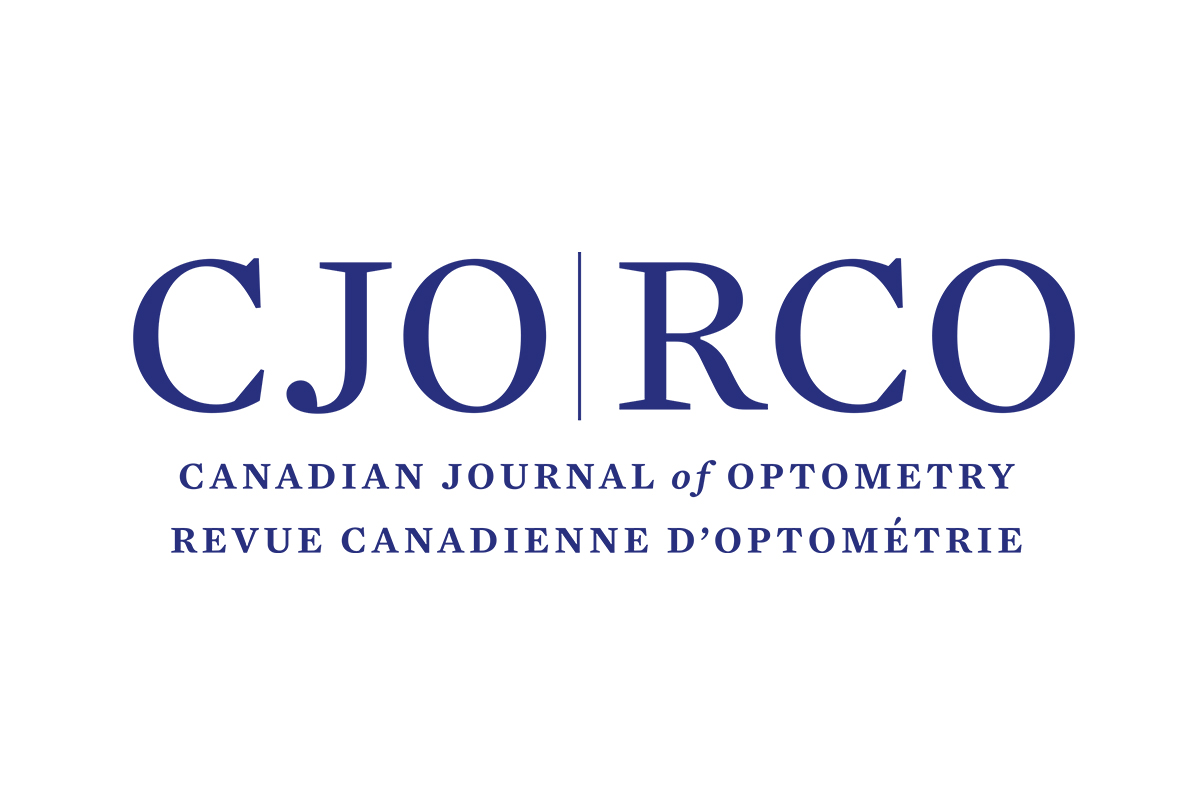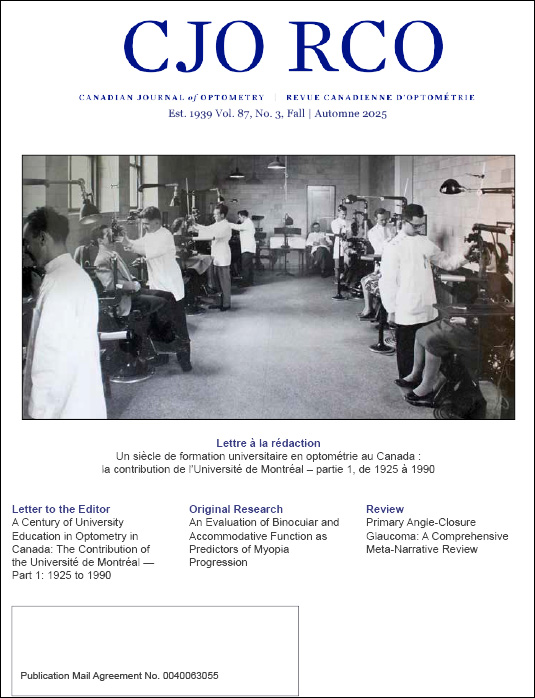Une évaluation des fonctions binoculaire et accommodative comme facteurs prédictifs de la progression de la myopie
DOI :
https://doi.org/10.15353/cjo.v87i3.6384Mots-clés :
myopie, vision binoculaire, accommodationRésumé
Résumé
Introduction
Cette étude a été conçue pour évaluer si des tests courants des fonctions binoculaire et accommodative peuvent prédire la progression de la myopie chez les enfants. Elle a porté sur des mesures cliniques moins étudiées, autres que le retard d’accommodation et la phorie.
Méthodologie
Cette étude de cohorte rétrospective a examiné les patients âgés de tout juste 5 ans à 17 ans moins un jour dans une clinique universitaire états-unienne située en milieu urbain. Les fonctions binoculaire et accommodative ont été mesurées dans un échantillon de 410 patients ayant une acuité visuelle corrigée normale. Ces fonctions ont été mises en corrélation avec l’évolution de la réfraction cycloplégique au fil du temps.
Résultats
La période d’observation moyenne était de 2,59 ans (± 0,70 an). Les coefficients de corrélation de Pearson entre les mesures des fonctions binoculaire et accommodative, et le changement réfractif étaient faibles (r = -0,02 à 0,03). L’exclusion des patients ayant un strabisme constant et la stratification selon le type de phorie (exotropie ou ésophorie), ainsi que des mesures de la vergence fusionnelle n’ont apporté aucune amélioration significative (r = -0,10 à 0,07). Même chez les patients à risque élevé de myopie et de progression de la myopie (réfraction de référence de ≤ 0,75 D), les corrélations sont demeurées faibles (r = -0,12 à 0,06).
Conclusion
Dans cet échantillon clinique, les résultats de tests courants des fonctions binoculaire et accommodative étaient indépendants des changements survenus dans l’erreur de réfraction, et aucune distinction n’a pu être établie entre l’apparition ou la progression future de la myopie.
Références
1. Holden BA, Fricke TR, Wilson DA, et al. Global Prevalence of Myopia and High Myopia and Temporal Trends From 2000 Through 2050. Ophthalmol. 2016;123(5):1036–42. doi:10.1016/j.ophtha.2016.01.006
2. Rudnicka AR, Kapetanakis VV, Wathern AK, et al. Global Variations and Time Trends in the Prevalence of Childhood Myopia, a Systematic Review and Quantitative Meta-Analysis: Implications for Aetiology and Early Prevention. Br J Ophthalmol. 2016;100(7):882–90. doi:10.1136/bjophthalmol-2015-307724
3. Han X, Liu C, Chen Y, He M. Myopia Prediction: A Systematic Review. Eye. (Lond) 2022;36(5):921–29. doi:10.1038/s41433-021-01805-6
4. Zadnik K, Sinnott LT, Cotter SA, et al. Prediction of Juvenile–Onset Myopia. JAMA Ophthalmol. 2015;133(6):683–89. doi:10.1001/jamaophthalmol.2015.0471
5. Kleinstein RN, Sinnott LT, Jones-Jordan LA, Sims J, Zadnik K. New Cases of Myopia in Children. Arch Ophthalmol. 2012;130(10):1274–79. doi:10.1001/archophthalmol.2012.1449
6. Jones-Jordan LA, Sinnott LT, Chu RH, et al. Myopia Progression as a Function of Sex, Age, and Ethnicity. Invest Ophthalmol Vis Sci. 2021;62(10):36. doi:10.1167/iovs.62.10.36
7. Jong M, Naduvilath T, Saw J, Kim K, Flitcroft DI. Association Between Global Myopia Prevalence and International Levels of Education. Optom Vis Sci. 2023;100(10):702–07. doi:10.1097/OPX.0000000000002067
8. Gopalakrishnan A, Hussaindeen JR, Sivaraman V, et al. Myopia and Its Association With Near Work, Outdoor Time, and Housing Type Among Schoolchildren in South India. Optom Vis Sci. 2023;100(1):105–10. doi:10.1097/OPX.0000000000001975
9. Deng L, Pang Y. Effect of Outdoor Activities in Myopia Control: Meta-Analysis of Clinical Studies. Optom Vis Sci. 2019;96(4):276–82. doi:10.1097/OPX.0000000000001357
10. Tideman JWL, Polling JR, Jaddoe VWV, Vingerling JR, Klaver CCW. Environmental Risk Factors Can Reduce Axial Length Elongation and Myopia Incidence in 6- to 9-Year-Old Children. Ophthalmology. 2019;126(1):127–36. doi:10.1016/j.ophtha.2018.06.029
11. Enthoven CA, Tideman JWL, Polling JR, Yang-Huang J, Raat H, Klaver CCW. The Impact of Computer Use on Myopia Development in Childhood: The Generation R Study [published corrigendum appears in Prev Med 2025 Apr;193:108243. doi: 10.1016/j.ypmed.2025.108243]. Prev Med. 2020 Mar;132:105988. doi:10.1016/j.ypmed.2020.105988
12. Tang SM, Kam KW, French AN, et al. Independent Influence of Parental Myopia on Childhood Myopia in a Dose-Related Manner in 2,055 Trios: The Hong Kong Children Eye Study [erratum appears in Am J Ophthalmol. 2022 Aug;240:353. doi: 10.1016/j.ajo.2022.03.001]. Am J Ophthalmol 2020 Oct;218:199–207. doi:10.1016/j.ajo.2020.05.026
13. French AN, Morgan IG, Mitchell P, Rose KA. Risk Factors for Incident Myopia in Australian Schoolchildren: The Sydney Adolescent Vascular and Eye Study. Ophthalmology. 2013;120(10):2100–08. doi:10.1016/j.ophtha.2013.02.035
14. Aslan F, Sahinoglu-Keskek N. The Effect of Home Education on Myopia Progression in Children During the COVID-19 Pandemic. Eye. 2022;36(7):1427–32. doi:10.1038/s41433-021-01655-2
15. Tricard D, Marillet S, Ingrand P, Bullimore MA, Bourne RRA, Leveziel N. Progression of Myopia in Children and Teenagers: A Nationwide Longitudinal Study. Br J Ophthalmol. 2022;106(8):1104–09. doi:10.1136/bjophthalmol-2020-318256
16. Gwiazda J, Thorn F, Bauer J, Held R. Myopic Children Show Insufficient Accommodative Response to Blur. Invest Ophthalmol Vis Sci. 1993;34(3):690–94.
17. Gwiazda J, Bauer J, Thorn F, Held R. A Dynamic Relationship Between Myopia and Blur-Driven Accommodation in School-Aged Children. Vision Res. 1995;35(9):1299–1304. doi:10.1016/0042-6989(94)00238-h
18. Allen PM, O’Leary DJ. Accommodation Functions: Co-Dependency and Relationship to Refractive Error. Vision Res. 2006;46(4):491–505. doi:10.1016/j.visres.2005.05.007
19. Goss DA. Clinical Accommodation and Heterophoria Findings Preceding Juvenile Onset of Myopia. Optom Vis Sci. 1991;68(2):110–16. doi:10.1097/00006324-199102000-00005
20. Price H, Allen PM, Radhakrishnan H, et al. The Cambridge Anti-Myopia Study: Variables Associated With Myopia Progression. Optom Vis Sci. 2013;90(11):1274–83. doi:10.1097/OPX.0000000000000067
21. Koomson NY, Amedo AO, Opoku-Baah C, Ampeh PB, Ankamah E, Bonsu K. Relationship Between Reduced Accommodative Lag and Myopia Progression. Optom Vis Sci. 2016;93(7):683–91. doi:10.1097/OPX.0000000000000867
22. Goss DA, Jackson TW. Clinical Findings Before the Onset of Myopia in Youth: 3. Heterophoria. Optom Vis Sci. 1996;73(4):269–78. doi:10.1097/00006324-199604000-0000
23. Goss DA, Rainey BB. Relationship of Accommodative Response and Nearpoint Phoria in a Sample of Myopic Children. Optom Vis Sci. 1999;76(5):292–94. doi:10.1097/00006324-199905000-00016
24. Walline JJ, Lindsley KB, Vedula SS, et al. Interventions to Slow Progression of Myopia in Children. Cochrane Database Syst Rev. 2020 Jan 13;1(1):CD004916. doi:10.1002/14651858.CD004916.pub4
25. Gwiazda JE, Hyman L, Norton TT, et al. Accommodation and Related Risk Factors Associated With Myopia Progression and Their Interaction With Treatment in COMET Children. Invest Ophthalmol Vis Sci. 2004;45(7):2143–51. doi:10.1167/iovs.03-1306
26. Modjtahedi BS, Abbott RL, Fong DS, Lum F, Tan D; Task Force on Myopia. Reducing the Global Burden of Myopia by Delaying the Onset of Myopia and Reducing Myopic Progression in Children: The Academy’s Task Force on Myopia. Ophthalmology. 2021;128(6):816–26. doi:10.1016/j.ophtha.2020.10.040
27. Hatch SW. Trends in Childhood Myopia in an Urban U.S. Clinic Population During the COVID-19 Pandemic. Vision Dev & Rehab. 2024;10(3):155–61. doi.org/10.31707/VDR2024.10.3.p155
28. Scheiman M, Wick B. Clinical Management of Binocular Vision, 4th Ed. Philadelphia: Lippencott, Williams & Wilkins, 2013.
29. Yazdani N, Sadeghi R, Momeni-Moghaddam H, Zarifmahmoudi L, Ehsaei A. Comparison of Cyclopentolate Versus Tropicamide Cycloplegia: A Systematic Review and Meta-Analysis. J Optom. 2018;11(3):135–43. doi: 10.1016/j.optom.2017.09.001
30. Bist J, Paudel N, Kandel S, Marasini S. Comparative Efficacy of Tropicamide 1% and Cyclopentolate 1% for Cycloplegic Refraction: A Systematic Review and Meta-Analysis of Randomized Controlled Trials. Optom Vis Sci. 2025;102(3):175–180. doi:10.1097/OPX.0000000000002226
Téléchargements
Publié-e
Comment citer
Numéro
Rubrique
Licence
© Stanley Hatch 2025

Cette œuvre est sous licence Creative Commons Attribution - Pas d'Utilisation Commerciale - Pas de Modification 4.0 International.


